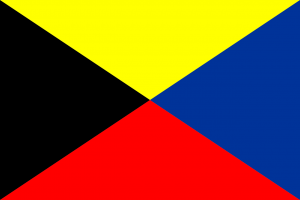Language/Zulu/Vocabulary/Numbers
Hello everybody,
➡ In today's lesson you will learn how to count in Zulu.
Feel free to edit this page if you think it could be improved!
Happy learning! 😊
After mastering this lesson, these related pages might interest you:Shapes, Colors, Family Members & How to say Good Bye?.
Cardinal Numbers[edit | edit source]
Counting with fingers in Zulu[edit | edit source]
The Zulus count on their fingers starting with the little finger of the left hand to the left thumb, and continuing with the thumb of the right hand. The numbers from six to nine retain the meaning of this method of counting: the word for six, isithupha, means "thumb", that for seven, isikhombisa, means "the one who designates", the number eight, isishiyagalombili, means " two remain”, and finally the number nine, isishiyagalolunye, means “only one remains”.
See this video:
Numbering rules in Zulu[edit | edit source]
Now that you have had an overview of the most common numbers, let's move on to the rules for writing tens, composite numbers, and why not hundreds, thousands and beyond (if possible).
Numbers from zero to nine are rendered by specific words: iqanda [0], kunye [1], kubili [2], kuthathu [3], kune [4], kuhlanu (or isihlanu) [5], isithupha [6 ], isikhombisa [7], isishiyagalombili [8] and isishiyagalolunye [9]. The digits one through five are actually roots prefixed with ku when used for counting in general, as are the digits five (its second form) through nine, prefixed with isi. When compounded, the root of the unit is prefixed with na, nam, nan, or nes depending on its first letter. Thus, the dialed digits are: nanye [1], nambili [2], nantathu [3], nane [4], nanhlanu (or nesihlanu) [5], nesithupha [6], nesikhombisa [7], nesishiyagalombili [8] and nesishiyagalolunye [9].
The names of the tens are constructed starting with the word amashumi (plural of ishumi, ten) before the multiplier digit separated by a space, with the exception of ten itself: ishumi [10], amashumi amabili [20], amashumi amathathu [30], amashumi amane [40], amashumi amahlanu [50], amashumi ayisithupha [60], amashumi ayisikhombisa [70], amashumi ayisishiyagalombili [80] and amashumi ayisishiyagalolunye [90]. Compound numbers are formed starting with the ten, then the compound form of the unit separated by a space (e.g.: ishumi nesikhombisa [17], amashumi amahlanu nesishiyagalolunye [59]).
The hundreds are formed with the word for hundred (ikhulu, and amakhulu in the plural), then the root of the multiplier digit prefixed by ama or ay according to its first letter, and separated by a space, except for hundred: ikhulu [100], amakhulu amabili [200], amakhulu amathathu [300], amakhulu amane [400], amakhulu amahlanu [500], amakhulu ayisithupha [600], amakhulu ayisikhombisa [700], amakhulu ayisishiyagalombili [800] and amakhulu ayisishiyagalolunye [900].
The thousands follow the same structure, the word for thousand being inkulungwane (plural of which is izinkulungwane), the unit prefix being ezim or ezin: inkulungwane [1,000], izinkulungwane ezimbili [2,000], izinkulungwane ezintathu [3,000], izinkulungwane ezine [4,000], izinkulungwane ezinhlanu [5,000], izinkulungwane eziyisithupha [6,000], izinkulungwane eziyisikhombisa [7,000], izinkulungwane eziyisishiyagalombili [8,000] and izinkulungwane galiyeishiya [90000] ezolyeish].
The following large numbers are: isigidi (million), whose plural is izigidi, then we have ibhiliyoni or isigidimbili (billion), ithriliyoni or isigidintathu (trillion), ikhwadriliyoni (billiard) and ikhwintiliyoni (trillion).
| Cardinal Number | isiZulu |
|---|---|
| 0 | iQanda |
| 1 | kuNye |
| 2 | kuBili |
| 3 | kuThathu |
| 4 | kuNe |
| 5 | isiHlanu |
| 6 | isiThupha |
| 7 | isiKhombisa |
| 8 | isiShiyagalombili, isiBhozo |
| 9 | isiShiyagalolunye |
| 10 | ishumi |
| 11 | iShumi nanye |
| 12 | iShumi nambili |
| 13 | iShumi nantathu |
| 14 | iShumi nane |
| 15 | iShumi nanhlanu |
| 16 | iShumi nesithupha |
| 17 | iShumi nesikhombisa |
| 18 | iShumi nesishiyagalombili |
| 19 | iShumi nesishiyagalolunye |
| 20 | amaShumi amabili |
| 30 | amaShumi amathathu |
| 40 | amaShumi amane |
| 50 | amaShumi amahlanu |
| 60 | amaShumi ayisithupha |
| 70 | amaShumi ayisikhombisa |
| 80 | amaShumi ayisishiyagalombili |
| 90 | amaShumi ayisishiyagalolunye |
| 100 | iKhulu / amaKhulu |
| 1,000 | inKulungwane / izinKulungwane |
| 1,000,000 | isiGidi / iziGidi |
| 1,000,000,000 | isiGidigidi / iziGidigidi |
Ordinal Numbers[edit | edit source]
| Ordinal Number | isiZulu | English |
|---|---|---|
| 1o | -okuqala | first |
| 2o | second | |
| 3o | isiThathu | third |
| -landela | next | |
| -gcinile | last |
Fractions[edit | edit source]
| Fraction | isiZulu | English |
|---|---|---|
| 1/2 | iHHafu | half |
| 1/3 | inGxenye yeSithathu / izinGxenye zeSithathu,
uCezu lweSithathu / izinGCezu zeSithathu |
third |
| 1/4 | iKota | quarter |
| % | iPhesenti / amaPhesenti | percent |
| isiBali / iziBali | calculator(s) |
Videos[edit | edit source]
How to count from 1 to 10 in Zulu[edit | edit source]
LEARN TO COUNT IN ZULU[edit | edit source]
Zulu numbers 1-10[edit | edit source]
Other Lessons[edit | edit source]
- Sports
- Feelings and Emotions
- Fruits
- Months of the year
- Days of the week
- Connecting words
- Tastes
- Colors
- Animals

